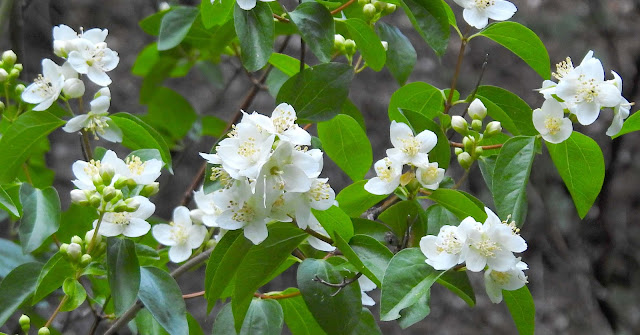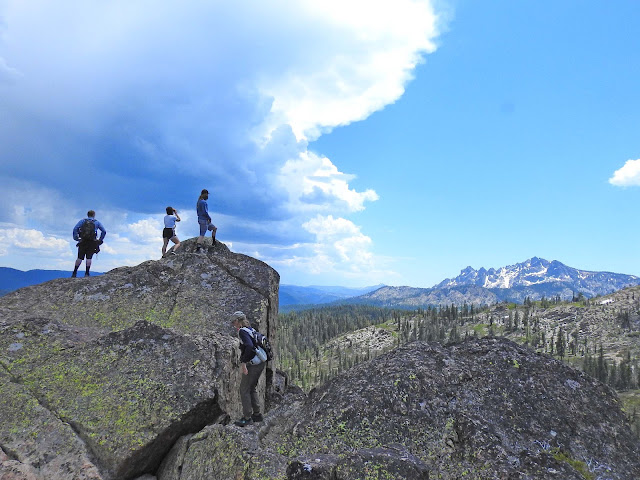Columbian Black-tailed Deer - Odocoileus hemionus columbianus
To my astonishment I spotted a doe and a little, spotted fawn in the river one morning this week! The doe froze when she saw me, which prompted the tiny fawn to instantly nurse! In another few seconds a second fawn joined the first fawn and also began nursing, right in the river!!! After about a minute the doe moved, the fawns stopped nursing, and they all crossed the river! Wow!!! I haven't seen any little fawns for years, and I never ever watched them nurse before! What a great sighting! Just wonderful!
Columbian Black-tailed Deer - Odocoileus hemionus columbianus
I posted this information about fawns about a year ago, but thought it was totally relevant right now! The following quote is from northernwoodlands.org.
"Young fawns’ scent glands are not well-developed. When a fawn is born, the doe licks it clean, removing odors that might alert predators. A few hours after birth, when the fawn can stand and walk, she moves it from the birth spot to a new hiding place. A fawn spends most of its first weeks of life bedded down alone. The doe stays away from her newborn except to nurse it periodically, and to lead it to new bed sites. That way her scent does not attract predators to the area where the fawn is hiding. If she has twins, which is common, the doe will typically hide them in separate places and make the rounds to nurse them. While the fawn nurses excitedly, its tail flicking, the doe licks its fur and genital areas to stimulate urination and defecation. She may also consume the fawn’s droppings to destroy evidence of its presence. Although secrecy is a fawn’s main defense, it has another: mom. If a fawn is in distress, it bleats, and the doe, which stays nearby, usually comes running, ready to defend it with her sharp hooves."
Fawns grow rapidly on their mother’s rich milk. By two to three weeks of age, they begin to nibble green vegetation. After a month, they will browse on tree seedlings. At this age, they begin to choose their own bedding sites and twins are reunited. By summer, young deer can outrun most danger, and trail their mother closely. Fawns usually are weaned at two to three months. In early autumn, a fawn’s spotted coat is replaced by the gray-brown winter coat of an adult deer. Female fawns usually stay with their mothers for two years; young bucks leave after a year. A buck fawn can be identified when only a few days old by the two round spots on its head where the antlers will grow."
Columbian Black-tailed Deer - Odocoileus hemionus columbianus
I hope I run across this beautiful, little family again soon!
Black Bear - Ursus americanus
A few weeks ago, I came across this medium-small sized bear in my neighborhood one morning! It was quietly eating grasses in a little meadow! I watched it for a minute or so until it scampered off into the woods! It had a lovely, shaggy, cinnamon-colored coat!
Black Bear - Ursus americanus
This is the fifth bear I've seen this year! I came across the bear in the right column, when I was driving up to the Lakes Basin a few weeks ago. It was along the side of the highway and crossed the road in front of me. It was darkish brown/black in color and was quite stocky! I only had time to get a quick photo before I drove on. How lucky I am to see these beautiful bears!
Gray Fox - Urocyon cinereoargenteus
The beautiful Gray Fox was back on our property one early evening last week! Wildlife is in and out of my view so quickly! Just had time to get this quick photo! Such beauty!
Stream Orchid - Epipactis gigantea
Over the last few weeks the local orchids have started to bloom! I found most of them in wet to damp seeps or bogs. They are bilaterally symmetrical, with 3 petals and 3 sepals in various arrangements. They also have species specific pollinators! The Stream Orchids pictured above grow in large colonies, from seeds and rhizomes, in areas with constant water. They are pollinated by Syrphid Flies, that are attracted to the honeydew scent of the flowers! These orchid flowers are large, being approximately 1.5" wide! This is just one of the hundreds of orchids that are blooming in a wet, seepy area I found along Highway 49!
Green Rein/Bog Orchid - Sierra Rein Orchid - Western Ladies Tresses
Platanthera sparsiflora - Platanthera dilitata - Spiranthes porrifolia
All of the orchids in the above photo were found in wet meadows. The orchid flowers are small, usually less than .5" wide. The Green Rein/Bog Orchid and the Sierra Rein Orchid are both pollinated by moths. The Sierra Rein Orchid has a lovely fragrance when it first opens! The Ladies Tresses are pollinated by native bees. The Green Rein/Bog Orchid and the Western Ladies Tresses are not as common as the Sierra Rein Orchid.
Mountain Piperia development over 6 weeks - Piperia transversa
The Mountain Piperia Orchid pictured above, doesn't grow in wet meadows or bogs. Instead, it grows in shady areas of the dry forest floor! I have been watching this plant for months! About two months ago, a pair of leaves appeared. After three weeks or so, a tiny floral stem emerged between the leaves. It took weeks for the stem to grow to its full height of 12", with tightly clustered flower buds pressed to the stem. The stem is only about as thick as an uncooked spaghetti noodle! Gradually the buds started to stick out from the stem, and then finally this week they bloomed into tiny, tiny orchid flowers, no more than .3" long! The flowers have a clove-like fragrance, which attracts moths. It was so fun to watch and wait for these orchids to bloom! They were quite a mystery to me!
Mock Orange - Philadelphus lewisii
Right now, the air in my neighborhood is filled with the lovely fragrance of blooming Mock Orange shrubs! It's heavenly! Whenever I look closely at the blossoms, there are lots of tiny black beetles feasting on the pollen. Some of them even eat the petals! This may be one of the last blooming shrubs, as the summer is heating up. So glad that it grows profusely in our area!
Below are photos of what's blooming currently in our neighborhood! Enjoy!
Keckiella - Brewer's Snapdragon - Whitestem Frasera
Keckiella breviflora - Antirrhinum vexillocalyculatum ssp. breweri - Frasera albicaulis
Washinton Lily - Leopard Lily
Lillium washingtonianum - Lillium pardalinum
Of these two lilies, only the Washington Lily has a fragrance.
A strong, sweet Easter-Lily-like scent! Just lovely!
Wickerstem Buckwheat (?)- Nude Buckwheat - Bear Buckwheat
Eriogonum vimineum (?)- Eriogonum nudum var. westonii -Eriogonum ursinum
Buckwheats usually bloom as the land dries out. Their dried flowers/seed heads will persist until the fall rains knock them down. I'm not sure if "Wickerstem Buckwheat" is the correct name, but it's my best guess.
The California Department of Fish and Wildlife dropped 100's of trout into the North Yuba River last week, and instantly an Osprey showed up on our section of the river!!! I hadn't seen an Osprey for months! I hope it sticks around! I so enjoy hearing their calls and watching them drop into the river feet-first to grab fish! Maybe I'll get lucky, and get a photo this year!
Mallard (female) and eight ducklings - Anas platyrhynchos
To my delight I spotted a Mallard momma with eight tiny ducklings on the river this week! They were keeping to the shallow edge of the river, in among the willows. I've never seen baby Mallards on the river before! What joy!
Common Merganser - Mergus merganser
There are now three Common Merganser females with ducklings on the river! The one pictured above, is the one I've been featuring with 8 ducklings. She still has all of her ducklings, but they are much larger. One of the other two females has 5 medium sized ducklings, and the other female has two tiny ducklings! How fun! I'll keep you posted on their development!
Recent raindrops
Damp Earth Art
Unfortunately we had some smoke this week, from a human caused wildfire about 40 miles away. Luckily only four structures were damaged, but the fire apparently burned a lot of the South Yuba River State Park, one of my absolutely favorite foothill parks. Approximately 900 acres were burned. Fire Season is now here. Hopefully more rainstorms will come soon. We really need them. Please join me in my continuing hope for precipitation! Perhaps our collective efforts may help it happen.
I'm going to keep posting rain inspired writings, art, etc. on my blog at dampearthart.blogspot.com. Any submissions would be greatly appreciated.
Wishing for peace in Ukraine and
an immediate end to this senseless war!
What's happening in the Lakes Basin?
Where do all the songbirds in my neighborhood overwinter?
Check back next week for the answers to these questions and more!
Unfortunately, you can no longer sign up to get my blog via email. Just go to northyubanaturalist.blogspot.com directly. It looks better than the emailed version!
Your questions and comments are greatly appreciated. Please feel free to email me at northyubanaturalist@gmail.com. Thanks!



















No comments:
Post a Comment